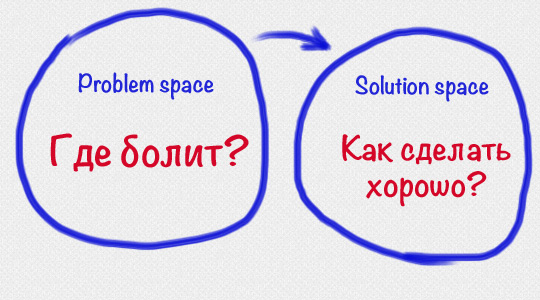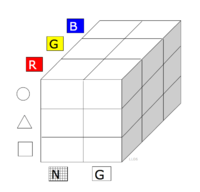Where do ideas come from?
This article contains all the ways I’ve known the search for (or “channels” of appearance) product ideas. In the form of a more or less ordered list.
The list will be useful to all who are engaged in the creation of new features, new products - product managers, startups and other people of creative professions.

')
Perhaps you have forgotten or did not know about any of these methods, and reading the article will help you overcome the next plug-in. Or it will encourage you to share some of your own, missed approach. Or even provoke indignation, and you want to tell how everything is “in reality” - feel free to supplement and criticize.
Obviously, the ideas themselves are not subject to any principles and classifications, they just appear. Usually in people's heads. But roughly to designate what pushes ideas to emerge, from which soil they grow, is very possible and necessary.
The question of the quality and value of ideas remains outside the scope of this article. It tells only where they come from.
In the IT sphere, today it is customary to consider ideas in the concepts of problem space and solution space ( another example ).

Not the fact that this is the optimal coordinate system (for example, in my opinion, many computer games do not solve any specific problem, but simply entertain). But it is popular, it works and we will not dispute it yet.
Suppose you have a goal or a task. It can be blurred and general (“I want a mobile application”), or it can be specific (“you need to make a website with halal recipes”).
To achieve a specific result (a specific product), you can first proceed from the problems that you want to solve. Many authors even consider this the only correct method of searching for ideas for new products and features.
Here are some ways to identify ways to find problems.

You can stumble upon an important, unresolved problem simply by talking to potential customers, users, customers (for whom do you want to make an application? What people do you want to see on your website with halal recipes?).
There are many different approaches, chips for interviewing and asking questions ( for example , a review of ways ). This is generally a separate story. But the point is one - to clarify the problems of people in an explicit form in the course of communication with these same people.
This way of finding problems is extremely important for understanding your audience, but do not expect brilliant product ideas on a silver platter.
Henry Ford is credited with the phrase “If I asked my clients what they needed, they would all answer — a faster horse!” Not many people would have pushed for a search for ways to speed up the horse, Ford saw an opportunity here (opportunity) and came to a number of new ideas already in the solution space.
The most banal and judging by the abundance of ugly and stupid products around us - the most undervalued way.
It is even embarrassing for adults to write about what they need to carefully monitor their users (real and potential), carefully analyze their observations, and draw conclusions.

It is not so important how to specifically analyze how to draw conclusions. It is important to just do it. Seriously and meaningfully, and not for show.
An important difference between this method and asking questions is that it is necessary to minimize interaction with those you observe. Otherwise, the effect of "taking me off" can spoil everything, you will not see the real picture.
But the ultimate goal is to discover the real problems of real people, and not to substantiate with their biased observation their ingenious, but often useless ideas.

For many well-known projects, it was an attempt to solve their own problems that served as the starting point for a successful journey.
The logic is simple - if it is really your pain, you should understand its nature like no one else and be able to evaluate the success of the decision. Having found a solution with which you are completely satisfied and for which you are ready to pay, you greatly increase the likelihood that this decision will be necessary for your comrades in misfortune.
Observation, sensitivity, the habit of constantly being aware of their reactions and motivation behind decisions and actions, the skill of noticing the imperfections of the world, getting to the bottom of things and critically looking at things helps to find out their own problems.
The main thing here is not to fall into the trap of false, contrived and thumb-sucked problems.
If you do not have friends and personal life, this is not a reason to create another social network (on the grounds that VKontakte or Facebook did not help you solve these problems).
It helps to ask yourself critical questions and try to answer as fully and honestly as possible. Investor, boss can pour in the ears, but it is dangerous to deceive yourself.
Why do I need a mobile app? What do I (or my customer, manager) want to achieve with another culinary site? And what does not suit me in the existing ones? Honestly, are these shortcomings so important? Why? How much am I willing to pay for a new solution? And so on.

Do you doubt that the acid-base balance is disturbed every time after eating? Have you ever been annoyed by sidewalks spattered with chewing gum a little less than completely?
I’ll stop here, for the audacity and skill in creating the problems of modern marketers has reached such heights that for many people they have long been turned into another global conspiracy ( http://ru.wikipedia.org/wiki/No_Logo and following the links).
But the way is the way. You can try to apply it in good intentions. For example, to turn non-halal food into a serious problem and to attract to the site a new target audience - the advocates of healthy lifestyles. And to you additional profit, and the people eating garbage will become less.
Here we will try to sort through the shelves where the ideas about the final products and features come from without being tied to problems.
This is when insight attends, grace descends, an inner voice speaks, an unexpected solution to some long-suffering problem, an interesting idea, thought, concept comes to mind.

There is a suspicion that this is how really great and big ideas are born. It is difficult to imagine how many well-known inventions and discoveries follow from previous knowledge. Often there is not enough of one small completely illogical step (there are many examples of this in science: the theory of relativity and other “quantum mechanics”).
Such a source of ideas is usually revealed to those who have long and seriously been brewing in a topic, who have already developed intuition and flair for what is happening in his subject area.
This is not a method from the series “Let's think of something and, for inspiration, go into a trance or take some substance.” It does not work.
There are a lot of speculations and legends around this channel of appearance (Newton's apple, Mendeleev’s table, and here’s another book, the idea of which came in a dream ), but the universe obviously doesn’t care much.
This method is difficult to clearly separate from the previous one because of its similarly random and unpredictable nature. And in order not to miss it, you also need to be attentive and sensitive to the products of your labor.

Many commercially successful ideas came about by chance, in the sense that they were not planned in advance or predicted.
The point of applying this approach is to, as a pioneer, be always ready for the fact that everything you do can turn to you a completely different side. And not always this side - ass.
There are many examples of this: tweeter , Punto Switcher (proof in an interview with the creator ), penicillin, and many, many others .
We are talking about different approaches to the systematization of creative search (TRIZ and the like).

Particularly curious for a long time in the subject and at least studied the article on Wikipedia . I will list some of the most popular techniques in real life.
Not every bunch of people chatting on a given topic is brainstorming, able to benefit. Brainstorming has a definite pattern .
The point is to strictly adhere to the rules and regulations: first, we generate ideas on a given topic, using including the partner’s ideas as starting points for our own people, any criticism is forbidden, and only then we analyze, criticize and sift ideas.
This way almost all people somehow use in their work, life and even personal life. Someone was not even too lazy and formulated his version in the form of the formal SCAMPER technique. They would have patented a triple click of the mouse ...
The meaning boils down to attempts to make random or intentional changes to individual parts of an idea, concept, or product, and see if something worthwhile comes out of it:
And so on, only more strictly and preferably according to a predetermined list of variations. To in a rush of inspiration do not forget to go through all the points.
The method , invented and successfully used by the Swiss astronomer in the case. It looks pretty tricky, but for our worldly affairs it can be simplified to the following simple scheme.
We take all the basic properties of an existing product (or class of products), summarize them in a table. Additional new properties add to taste. Then we go through all the possible combinations in an attempt to find a fresh interesting one.
For example, take the popular iOS game Clash of Clans. What properties can be distinguished from similar products? Setting games (vikings, knights, military base, fantastic civilizations, etc.), monetization model (free-to-play, subscription, paid application, ..), graphics (3D, rendered 3D sprites, cartoon, photorealistic, ...) , gameplay and so on.
Each property and its value set can be selected from existing applications on the market and add your own.

We get some table (by and large multidimensional). At this table, you can scatter competitors and get a visual map of "military action".
And also accumulate a wagon of new ideas in the spirit of “and if you make Clash of clans in the setting of the third Reich with photo-realistic graphics and a subscription model? ..”
The more detailed you break the properties, the more difficult and tedious the search process will be, but the more likely it is to find something worthwhile.
The method, known at all times and playing in my opinion a crucial role in the progress of mankind. He has two flavors.
And also to spy, slyamzit, clone, hijack, learn, borrow ...

This is when we take a successful discovery of a competitor and stupidly copy it, not trying to get deep into the logic and motivation behind this or that decision. Cheap, angry and often justified and effective.
China and the USSR have achieved particular success in this approach (for example, the history of the creation of the Tu-4 bomber , where even ashtrays were copied, is amusing, for example, although our pilots were not allowed to smoke).
If you are not the USSR and not China, exploiting only this path, you, for a number of obvious reasons, risk always remaining in the role of catching up and sooner or later fly out of the market.
We look at successful features and products of competitors, we understand the background and the likely reasons for their success and popularity, we identify key weaknesses and shortcomings.

We skip it all through ourselves, through our capabilities, plans, resources and ambitions. Create a product or feature similar to a competitor, but better.
Under this item, you can optionally bring Google, Facebook and thousands of other well-known companies that have become leaders of their market, being not the first. But who offered the best product.
Of course, they did not become leaders because they analyzed competitors and only tried to improve their solutions. And not even because of the one that offered the best
But after all, we are classifying ways to search for product ideas, rather than doing business analysis.
This is when ideas, solutions, patterns, already known and tested in one area are transferred to another.

The most superficial example is the direct transfer of processes from offline to online. People in real life, alas, constantly fighting. And in the gaming industry are constantly emerging new shooters and strategies about the war.
A little deeper is the desktop metaphor (as well as files, folders, recycle bin, etc.), which for many years ahead set the vector for the development of computer interfaces. The basis of this idea is obviously not invented from scratch.
Many inventions and technical ideas were taken from nature ( reference for the curious ).
However, the similarity of principles and patterns from completely different areas of life is a separate interesting topic for the flame, we are now more interested in the applied aspect.
It lies in the fact that looking into other areas of human activity (in other industries, other countries, other companies, other cultures, other markets, other epochs) you can find many interesting solutions for your tasks.
This is the proposed classification. The benefits of it are more educational and developing than applied. But this is more than enough reason for an article in our young industry. Moreover, attempts to systematize and analyze product management processes are still very rare.
I count on your comments, criticism and additions, dear colleagues, like-minded people and just curious readers.
The list will be useful to all who are engaged in the creation of new features, new products - product managers, startups and other people of creative professions.

')
Perhaps you have forgotten or did not know about any of these methods, and reading the article will help you overcome the next plug-in. Or it will encourage you to share some of your own, missed approach. Or even provoke indignation, and you want to tell how everything is “in reality” - feel free to supplement and criticize.
Obviously, the ideas themselves are not subject to any principles and classifications, they just appear. Usually in people's heads. But roughly to designate what pushes ideas to emerge, from which soil they grow, is very possible and necessary.
The question of the quality and value of ideas remains outside the scope of this article. It tells only where they come from.
Intro
In the IT sphere, today it is customary to consider ideas in the concepts of problem space and solution space ( another example ).

Not the fact that this is the optimal coordinate system (for example, in my opinion, many computer games do not solve any specific problem, but simply entertain). But it is popular, it works and we will not dispute it yet.
1. Problem space
Suppose you have a goal or a task. It can be blurred and general (“I want a mobile application”), or it can be specific (“you need to make a website with halal recipes”).
To achieve a specific result (a specific product), you can first proceed from the problems that you want to solve. Many authors even consider this the only correct method of searching for ideas for new products and features.
Here are some ways to identify ways to find problems.
1.1 Ask questions

You can stumble upon an important, unresolved problem simply by talking to potential customers, users, customers (for whom do you want to make an application? What people do you want to see on your website with halal recipes?).
There are many different approaches, chips for interviewing and asking questions ( for example , a review of ways ). This is generally a separate story. But the point is one - to clarify the problems of people in an explicit form in the course of communication with these same people.
This way of finding problems is extremely important for understanding your audience, but do not expect brilliant product ideas on a silver platter.
Henry Ford is credited with the phrase “If I asked my clients what they needed, they would all answer — a faster horse!” Not many people would have pushed for a search for ways to speed up the horse, Ford saw an opportunity here (opportunity) and came to a number of new ideas already in the solution space.
1.2 Watch
The most banal and judging by the abundance of ugly and stupid products around us - the most undervalued way.
A lot of everyday examples of deaf-blindness product creators can be seen in the book "Design of familiar things" by Norman .
It is even embarrassing for adults to write about what they need to carefully monitor their users (real and potential), carefully analyze their observations, and draw conclusions.

It is not so important how to specifically analyze how to draw conclusions. It is important to just do it. Seriously and meaningfully, and not for show.
An important difference between this method and asking questions is that it is necessary to minimize interaction with those you observe. Otherwise, the effect of "taking me off" can spoil everything, you will not see the real picture.
But the ultimate goal is to discover the real problems of real people, and not to substantiate with their biased observation their ingenious, but often useless ideas.
1.3 Own problems

For many well-known projects, it was an attempt to solve their own problems that served as the starting point for a successful journey.
The logic is simple - if it is really your pain, you should understand its nature like no one else and be able to evaluate the success of the decision. Having found a solution with which you are completely satisfied and for which you are ready to pay, you greatly increase the likelihood that this decision will be necessary for your comrades in misfortune.
Observation, sensitivity, the habit of constantly being aware of their reactions and motivation behind decisions and actions, the skill of noticing the imperfections of the world, getting to the bottom of things and critically looking at things helps to find out their own problems.
The main thing here is not to fall into the trap of false, contrived and thumb-sucked problems.
If you do not have friends and personal life, this is not a reason to create another social network (on the grounds that VKontakte or Facebook did not help you solve these problems).
It helps to ask yourself critical questions and try to answer as fully and honestly as possible. Investor, boss can pour in the ears, but it is dangerous to deceive yourself.
Why do I need a mobile app? What do I (or my customer, manager) want to achieve with another culinary site? And what does not suit me in the existing ones? Honestly, are these shortcomings so important? Why? How much am I willing to pay for a new solution? And so on.
1.4 Create problem

Do you doubt that the acid-base balance is disturbed every time after eating? Have you ever been annoyed by sidewalks spattered with chewing gum a little less than completely?
I’ll stop here, for the audacity and skill in creating the problems of modern marketers has reached such heights that for many people they have long been turned into another global conspiracy ( http://ru.wikipedia.org/wiki/No_Logo and following the links).
But the way is the way. You can try to apply it in good intentions. For example, to turn non-halal food into a serious problem and to attract to the site a new target audience - the advocates of healthy lifestyles. And to you additional profit, and the people eating garbage will become less.
2. Solution space
Here we will try to sort through the shelves where the ideas about the final products and features come from without being tied to problems.
2.1 Intuitive-mystical way
This is when insight attends, grace descends, an inner voice speaks, an unexpected solution to some long-suffering problem, an interesting idea, thought, concept comes to mind.

There is a suspicion that this is how really great and big ideas are born. It is difficult to imagine how many well-known inventions and discoveries follow from previous knowledge. Often there is not enough of one small completely illogical step (there are many examples of this in science: the theory of relativity and other “quantum mechanics”).
Such a source of ideas is usually revealed to those who have long and seriously been brewing in a topic, who have already developed intuition and flair for what is happening in his subject area.
This is not a method from the series “Let's think of something and, for inspiration, go into a trance or take some substance.” It does not work.
There are a lot of speculations and legends around this channel of appearance (Newton's apple, Mendeleev’s table, and here’s another book, the idea of which came in a dream ), but the universe obviously doesn’t care much.
2.2 Random ideas or by-products
This method is difficult to clearly separate from the previous one because of its similarly random and unpredictable nature. And in order not to miss it, you also need to be attentive and sensitive to the products of your labor.

Many commercially successful ideas came about by chance, in the sense that they were not planned in advance or predicted.
The point of applying this approach is to, as a pioneer, be always ready for the fact that everything you do can turn to you a completely different side. And not always this side - ass.
There are many examples of this: tweeter , Punto Switcher (proof in an interview with the creator ), penicillin, and many, many others .
2.3 Methodical search for solutions or scientific path
We are talking about different approaches to the systematization of creative search (TRIZ and the like).

Particularly curious for a long time in the subject and at least studied the article on Wikipedia . I will list some of the most popular techniques in real life.
Brainstorm
Not every bunch of people chatting on a given topic is brainstorming, able to benefit. Brainstorming has a definite pattern .
The point is to strictly adhere to the rules and regulations: first, we generate ideas on a given topic, using including the partner’s ideas as starting points for our own people, any criticism is forbidden, and only then we analyze, criticize and sift ideas.
Method "what if?"
This way almost all people somehow use in their work, life and even personal life. Someone was not even too lazy and formulated his version in the form of the formal SCAMPER technique. They would have patented a triple click of the mouse ...
The meaning boils down to attempts to make random or intentional changes to individual parts of an idea, concept, or product, and see if something worthwhile comes out of it:
- And what if you swap the cap and basement of the site with recipes?
- And what if halal recipes are replaced by kosher?
- And what if you remove the texts from the recipes?
- And what if the video add audio recipes?
And so on, only more strictly and preferably according to a predetermined list of variations. To in a rush of inspiration do not forget to go through all the points.
Morphological analysis
The method , invented and successfully used by the Swiss astronomer in the case. It looks pretty tricky, but for our worldly affairs it can be simplified to the following simple scheme.
We take all the basic properties of an existing product (or class of products), summarize them in a table. Additional new properties add to taste. Then we go through all the possible combinations in an attempt to find a fresh interesting one.
For example, take the popular iOS game Clash of Clans. What properties can be distinguished from similar products? Setting games (vikings, knights, military base, fantastic civilizations, etc.), monetization model (free-to-play, subscription, paid application, ..), graphics (3D, rendered 3D sprites, cartoon, photorealistic, ...) , gameplay and so on.
Each property and its value set can be selected from existing applications on the market and add your own.

We get some table (by and large multidimensional). At this table, you can scatter competitors and get a visual map of "military action".
And also accumulate a wagon of new ideas in the spirit of “and if you make Clash of clans in the setting of the third Reich with photo-realistic graphics and a subscription model? ..”
The more detailed you break the properties, the more difficult and tedious the search process will be, but the more likely it is to find something worthwhile.
2.4. Competitive analysis
The method, known at all times and playing in my opinion a crucial role in the progress of mankind. He has two flavors.
Lick
And also to spy, slyamzit, clone, hijack, learn, borrow ...

This is when we take a successful discovery of a competitor and stupidly copy it, not trying to get deep into the logic and motivation behind this or that decision. Cheap, angry and often justified and effective.
China and the USSR have achieved particular success in this approach (for example, the history of the creation of the Tu-4 bomber , where even ashtrays were copied, is amusing, for example, although our pilots were not allowed to smoke).
If you are not the USSR and not China, exploiting only this path, you, for a number of obvious reasons, risk always remaining in the role of catching up and sooner or later fly out of the market.
To develop
We look at successful features and products of competitors, we understand the background and the likely reasons for their success and popularity, we identify key weaknesses and shortcomings.

We skip it all through ourselves, through our capabilities, plans, resources and ambitions. Create a product or feature similar to a competitor, but better.
Under this item, you can optionally bring Google, Facebook and thousands of other well-known companies that have become leaders of their market, being not the first. But who offered the best product.
Of course, they did not become leaders because they analyzed competitors and only tried to improve their solutions. And not even because of the one that offered the best
But after all, we are classifying ways to search for product ideas, rather than doing business analysis.
2.5 Analogies
This is when ideas, solutions, patterns, already known and tested in one area are transferred to another.

The most superficial example is the direct transfer of processes from offline to online. People in real life, alas, constantly fighting. And in the gaming industry are constantly emerging new shooters and strategies about the war.
A little deeper is the desktop metaphor (as well as files, folders, recycle bin, etc.), which for many years ahead set the vector for the development of computer interfaces. The basis of this idea is obviously not invented from scratch.
Many inventions and technical ideas were taken from nature ( reference for the curious ).
However, the similarity of principles and patterns from completely different areas of life is a separate interesting topic for the flame, we are now more interested in the applied aspect.
It lies in the fact that looking into other areas of human activity (in other industries, other countries, other companies, other cultures, other markets, other epochs) you can find many interesting solutions for your tasks.
This is the proposed classification. The benefits of it are more educational and developing than applied. But this is more than enough reason for an article in our young industry. Moreover, attempts to systematize and analyze product management processes are still very rare.
I count on your comments, criticism and additions, dear colleagues, like-minded people and just curious readers.
Source: https://habr.com/ru/post/176171/
All Articles